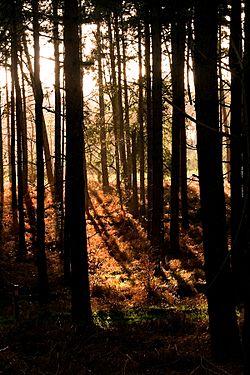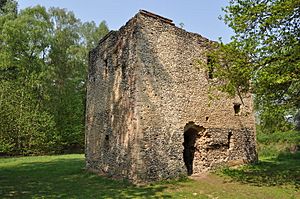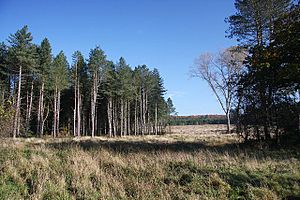Thetford Forest facts for kids
Quick facts for kids Thetford Forest |
|
|---|---|

A view of the forest
|
|
| Type | Woodland |
| Location | Norfolk and Suffolk |
| Area | 19,000 ha (47,000 acres) |
| Created | 1922 |
| Operated by | Forestry Commission |
| Visitors | 1 million+ |
| Open | All year |
| Website | Forestry Commission |
Thetford Forest is the biggest lowland pine forest in Britain. It is located in England, across parts of Suffolk and Norfolk. This huge forest covers more than 19,000 ha (47,000 acres) of land. It is also a special protected area called a Site of Special Scientific Interest.
Contents
History of Thetford Forest
Thetford Forest was planted after World War I (the First World War). This was to make sure Britain had enough wood. Many oak trees and other slow-growing trees had been used during the war. The Forestry Commission manages the forest.
When the forest was created, it changed the local environment. This area, called Breckland, used to have lots of gorse bushes and sandy hills. The new trees stopped the strong winds from blowing sand everywhere. Before the forest, people had changed the land by mining flint and creating rabbit warrens. Grime's Graves is an ancient flint mine found inside the forest.
How the Forest Was Made
Getting the Land for the Forest
After World War I, many large land owners in England were struggling. This was especially true in areas with poor soil like Breckland. Farms were empty, and land was left unused. The Forestry Commission was set up around this time. In 1922, they started buying land for Thetford Forest. Most of the forest land was bought in the 1920s and 1930s. It came from big old estates.
Working in the Forest
From the very beginning, decisions about the forest were made locally. These decisions happened at the offices in Santon Downham. Many people were hired to work in the forest. This was good because many people were looking for jobs in rural Britain.
During the 1920s, there were many people without jobs in the Breckland area. The Forestry Commission easily found people to work. Many workers were happy to get a job that included a house. By the late 1920s, people from areas with high unemployment, like miners from the North of England, came to live and work in the forest.
As the Great Depression got worse, training camps were set up. From 1928 to 1938, many camps were built. These camps housed thousands of men who were learning forestry skills. These programs ended when World War II began.
During World War II, there were not enough workers. Many local men joined the armed forces. This led to many women working in the forest. They helped with timber production. By 1943, the Women's Land Army had a training camp near the forest. After the war, fewer women worked there.
In 1946, a training program started for soldiers returning from the war. By 1950, about 570 people worked in the forest. Later, new machines and weedkillers made the work easier. By the mid-1970s, the number of workers was similar to the 1930s.
Planting the Trees
Collecting Seeds
To plant such a huge forest, a lot of tree seeds were needed. Many seeds came from the local area. Men and women went out to collect cones from existing trees. As the new forest grew, seeds could be collected from its own trees.
From 1925 to 1964, a special unit at Santon Downham removed seeds from the cones. Once the seeds grew into small plants, they were moved to a nursery. They stayed there for one to two years before being planted in the forest.
Types of Trees Planted
As soon as the land was bought, planting began. Most of the forest was planted within the first 20 years. The scots pine was chosen first. This was because it grew well in the local conditions. Also, its seeds were easy to find nearby.
However, the corsican pine was also planted from the early 1920s. Today, it is the most common tree in the forest. It is stronger against diseases and pests. It also grows well in the thin, chalky soil. It produces more wood per acre.
Other conifer trees like Douglas fir and larch were also planted. But they did not grow as well as the pines. Many native hardwood trees were planted in the 1920s and 1930s. Oak and beech trees were sometimes harmed by spring frosts. Deer also ate young beech trees. Oak trees grew better but much slower than pines. So, fewer oak trees were planted over time.
However, hardwood trees are still planted along roads. They help stop fires from spreading. Besides oak and beech, other trees like lime, walnut, red oak, and maple have also been planted.
The Forest Grows Up
Taking Care of the Trees
When the trees were about 20 feet tall, their lower branches were removed. This process is called brashing. It made it easier to walk through the forest. It also reduced the risk of fire. The first six feet of the tree would also have fewer knots in the wood.
Next, after 15 to 16 years, some diseased trees were removed. This was called pre-thinning. Larger trees that blocked smaller, straighter trees were also taken out.
Thinning began when the trees were 18 to 20 years old. This was around the start of World War II. Paths called racks were cut through the forest. These paths were about 18 to 20 feet wide. The removed trees were used for many things. Straight poles became pit props for the coal industry. Other pieces were used for fences or garden stakes. Curved wood was sold as firewood.
In 1946, a special center was set up in Brandon. It processed poles into pit-props for coal mines. A lot of wood waste was created. This led to a new business: charcoal burning.
As the forest grew, more and more trees were thinned out. By 1950, there was less demand for timber from the coal industry. The Forestry Commission had to find new uses for the wood. Smaller poles were cut into wallboard. Some pine wood was sent to a factory to make wood wool.
In the mid-1960s, chainsaws were introduced. By the early 1980s, special tractors called forwarders were used. In 1991, harvester machines arrived. This meant the forest work was fully mechanized. By 1997, about 2500 trees were cut each day. This produced a lot of timber every year. Most of this wood is sold to local sawmills for building. The rest is used for fence posts, pallets, and pit props.
Protecting Nature in the Forest
More and more people have visited Thetford Forest since the 1950s. Now, over a million people visit each year. Areas where trees have been cut down create open spaces. These spaces make the forest nicer for walking and picnics.
These changes have also brought more wildlife. Birds like crossbills and sparrowhawks now nest there. This has made the forest more interesting for nature lovers.
In 1990, Thetford Forest was named a Forest Park. This showed how important it was for recreation and wildlife. The High Lodge visitor center opened in 1992. This center helps people enjoy the forest.
Conservation efforts have greatly increased. By 1991, a group of experts was set up to help protect the forest. English Nature has named 11 areas within the forest as SSSIs. These areas protect special Breckland habitats.
Forest Animals and Plants (Biodiversity)
Thetford Forest is mostly surrounded by farms and villages. But it has many different kinds of plants and animals. It is home to many hares, rabbits, and gamebirds. Several types of deer also live there. These include muntjac, roe deer, and a small number of red deer.
The forest is famous for its rare breeding birds. These include woodlarks, nightjars, goshawks, crossbills, and siskins. There are also golden pheasants that were brought to the area. You can find many of these birds at the Mayday recreation site. Stone curlews nest near the edges of the forest. Sometimes, a great grey shrike spends the winter there.
High Lodge Visitors Centre
The High Lodge Visitors Centre opened in 1992. It has a cafe, bike rentals, and fun play areas. There are also walking trails and outdoor concerts. You can even find a Go Ape high wire adventure course there.
Mountain Biking Fun
Thetford Forest is a very popular place for mountain biking. It has several marked trails for all skill levels. There are easy trails for families. There are also two "red trails" for experienced riders. The forest has hundreds of miles of other trails. Some parts have steep hills, like "The Beast" at the end of the Lime Burner Trail.
National cross-country cycling races are held in the forest. A group called TIMBER works with the Forestry Commission. They help make the mountain bike trails even better.
Other Cool Activities
The ancient Roman road called Peddars Way ends in Thetford Forest. It connects to other walking paths in the forest. There is also a treetop adventure course called 'Go Ape'. A Center Parcs holiday resort is located nearby at Elveden. This resort brings many visitors to the area. The British Siberian Husky Racing Association holds husky racing events in the forest each winter.
Military Training Area
A large part of Thetford Forest is used for military training. This area is called the Stanford Training Area. The public is not allowed to enter this part of the forest.
Getting Around the Forest
Four main roads cross through the forest. These are the A11, A134, A1064, and A1065. There are also many smaller roads. The towns of Brandon and Thetford are connected by a railway. The Little Ouse Path also follows the River Little Ouse through the forest.





